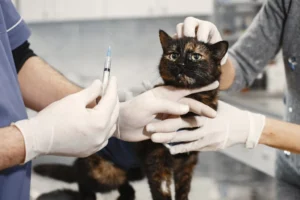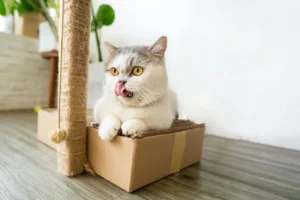Have you ever caught your feline friend digging at mirrors around your house? You might be wondering why they exhibit this behavior. Let’s explore the possible reasons behind why your cat digs at mirrors.
Cats and Their Reflections: Why Do They Dig at Mirrors?
Natural Instincts: Exploring Your Cat’s Hunting Behaviors
Have you ever noticed your cat digging at mirrors? It might seem odd, but it actually stems from their natural instincts as hunters. Cats are wired to be curious and investigative creatures, always on the lookout for potential prey. When they see their reflection in a mirror, they may perceive it as another animal intruding on their territory, triggering their hunting instincts.
Feline hunting behaviors include stalking, pouncing, and scratching , which can explain why your cat acts out towards their reflection. They might paw at the mirror, trying to catch what they see as a moving target, or even vocalize their displeasure at the perceived threat.
To help satisfy your cat’s hunting instincts , consider providing interactive toys and play sessions that simulate prey-like movements. This can redirect their energy towards more appropriate outlets and prevent them from fixating on their reflection in the mirror.
For further insights on understanding your cat’s behaviors, you can explore this resource on feline hunting instincts: Understanding Your Cat’s Hunting Instincts
Stress and Anxiety: Unpacking Your Cat’s Emotions
When a cat digs at mirrors, it can also be a sign of stress and anxiety. Cats are sensitive creatures that can easily become overwhelmed by changes in their environment or routine, leading to abnormal behaviors like mirror digging.
If your cat is feeling stressed, they may try to assert control by engaging in repetitive behaviors like scratching at mirrors. It’s their way of coping with uncertainty and asserting their dominance in a situation that makes them feel unsettled.
To help alleviate your cat’s stress and anxiety , create a calm and secure environment for them. Ensure they have hiding spots, comforting scents, and a consistent routine to feel more at ease. If the behavior persists, consider consulting with a veterinarian or animal behaviorist for additional support.
Remember, understanding your cat’s emotions and addressing their needs is essential for their overall well-being and happiness.
Natural Scratching Behavior: Understanding Your Cat’s Need to Scratch
Cats have an innate need to scratch to maintain their claws, mark their territory, and stretch their muscles. Mirrors, with their smooth surface and reflective qualities, may attract your cat’s scratching behavior simply because they offer a different texture and visual stimulation. To prevent your cat from damaging your mirrors, provide alternative scratching posts or pads made of carpet, cardboard, or sisal. Additionally, regularly trim your cat’s claws to minimize the impact of their scratching habits on your mirrors.
Curiosity and Playfulness: How Your Cat’s Inquisitive Nature Comes Into Play
Cats are curious creatures by nature, and their playful demeanor often leads them to investigate unfamiliar objects, including their own reflection in a mirror. Your cat may dig at the mirror out of sheer fascination or as a form of entertainment. Consider placing interactive toys or puzzle feeders near the mirror to redirect your cat’s attention and keep them mentally stimulated. You can also try covering the mirror temporarily to discourage this behavior while providing engaging activities elsewhere.
Tips to Deter Your Cat from Digging at Mirrors:
- Provide Adequate Scratching Surfaces: Offer a variety of scratching posts and pads in different textures to satisfy your cat’s scratching needs.
- Use Deterrents: Spritz a cat-safe deterrent spray on the mirror’s surface to discourage your cat from scratching or digging at it.
- Engage in Interactive Play: Spend quality time playing with your cat using toys that promote mental and physical stimulation to redirect their attention from the mirror.
- Consult a Veterinarian: If your cat’s digging behavior persists despite interventions, consult with your veterinarian to rule out any underlying medical issues or behavioral concerns.
By understanding your cat’s natural instincts and providing appropriate outlets for their scratching and playfulness, you can help curb their fascination with mirrors and promote a harmonious living environment for both you and your feline friend.
Redirected Aggression: When Your Cat’s Frustrations Manifest in Unexpected Ways
Have you ever wondered why your cat digs at mirrors? It might actually be a sign of redirected aggression. When your feline friend sees their reflection in the mirror, they may mistake it for another cat invading their territory. This can lead to frustration, confusion, and ultimately, digging behavior.
To address this issue, it’s essential to provide your cat with proper outlets for their natural instincts. One way to do this is by creating a stimulating environment that offers alternative activities for them to engage in. This could include interactive toys, scratching posts, puzzle feeders, and climbing structures.
Additionally, ensure that your cat has access to plenty of mental and physical stimulation throughout the day. Regular play sessions, hiding treats for them to find, and creating cozy resting spots can all help alleviate their stress and prevent redirected aggression from escalating into mirror-digging behavior.
Remember, your cat’s instincts are strong, but with the right environment and attention, you can help redirect their energy in a positive way.
Environmental Enrichment: Providing Stimulating Alternatives to Mirror Digging
In addition to addressing redirected aggression, environmental enrichment plays a crucial role in preventing your cat from digging at mirrors. By offering a variety of enriching activities, you can keep your feline friend mentally and physically stimulated, reducing the likelihood of them engaging in unwanted behaviors.
Here are some tips to enhance your cat’s environment and provide stimulating alternatives to mirror digging:
- Interactive Toys: Invest in toys that require your cat to problem-solve or engage in physical activity.
- Scratching Posts: Provide multiple scratching posts throughout your home to fulfill your cat’s natural scratching instinct.
- Vertical Space: Cats love to climb and perch up high, so consider adding cat trees or shelves for them to explore.
- Window Perches: Create a cozy spot by a window where your cat can watch the world outside.
- Rotate Toys: Keep your cat engaged by rotating their toys regularly to prevent boredom.
By incorporating these enrichment strategies into your cat’s daily routine, you can minimize their urge to dig at mirrors and create a happy, healthy environment for them to thrive in.
Fun Facts About Cats and Mirrors
Cats are curious creatures by nature, so it’s no surprise that they often find mirrors fascinating. When your furry friend starts digging at their own reflection in the mirror, it can be a puzzling sight. But fear not, there are some interesting facts about cats and their interactions with mirrors that might shed some light on this behavior.
- Cats see mirrors differently: Contrary to popular belief, cats don’t recognize themselves in the mirror like humans do. They perceive their reflection as another cat or intruder, which can trigger their instinct to investigate or even engage in playful behavior.
- Natural hunters: Cats are skilled hunters, and the movement they see in the mirror can resemble prey. When they dig at the mirror, they might be trying to ‘catch’ the elusive ‘intruder’ on the other side.
- Territorial instincts: Your cat’s digging behavior could also be a way of marking their territory. By scratching at the mirror, they might be leaving their scent behind as a way of claiming their ‘territory’ from the ‘intruder.’
Next time you catch your cat digging at the mirror, remember these fun facts about their behavior. It’s all just part of their curious and playful nature!
For more insights into cat behaviors and how to better understand your feline friend, check out this helpful resource.
Alex, a passionate animal lover, has experience in training and understanding animal behavior. As a proud pet parent to two dogs and three cats, he founded AnimalReport.net to share insights from animal experts and expand his knowledge of the animal kingdom.









